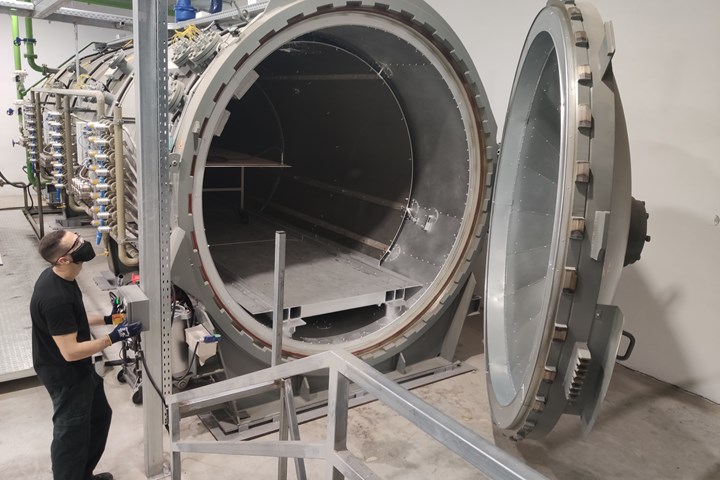Kanfit installs new autoclave, automated cutter to increase composite parts production capacity
Composite parts producer in Israel increases capabilities for composites, 3D printing and hybrid assemblies.

Kanfit Ltd. (Nof Hagalil, Israel) has installed a new 2.5-meter-diameter by 8.2-meter long autoclave from Scholz (Coesfeld, Germany), adding to its 2.1-meter-diameter by 5.5-meter-long autoclave from ASC Process Systems (Valencia, Calif., U.S.), which has served the company’s production needs since 2015. The new Scholz autoclave was purchased to increase Kanfit's in-autoclave production capacity as well as to manufacture larger parts. The new Scholz autoclave is 2.5 times larger in volume than its ASC autoclave, and allows the production of parts up to 8.2 meters long.
In addition, Kanfit added a Zünd (Altstätten, Switzerland) fabric cutting machine with conveyor table. The company's new cleanroom has doubled to 400 square meters and its prepreg storage freezers have twice the capacity of its previous plant in Migdal Ha'Emek.
Three new LASERGUIDE projections systems from Aligned Vision (Chelmsford, Mass., U.S.) were also added to the four already in place. A new fume hood from Pach Taas (Ashkelon, Israel) has also been added for mold preparation, as well as new laboratory equipment to increase Kanfit’s composite testing capabilities, including a 100-kilonewton universal testing machine from Shimadzu (Kyoto, Japan) and a thermal-mechanical analysis system for glass transition temperature and dynamic mechanical analysis (DMA) from TA Instruments (New Castle, Del., U.S.).
Kanfit Ltd.’s sister company, KANFIT3D, also recently increased its production capacity, installing an SLM M280 selective laser melting system for aluminum parts. KANFIT3D has begun additive manufacturing of 3D components for the aerospace industry.
“Both the autoclave and SLM machine were installed remotely,” notes Shachar Fine, Kanfit executive vice president of business development, marketing & sales. “As far as we are aware, this is the first time that remote installation has been performed for both of these systems. We are already manufacturing parts according to customer requirements.”
“Fortunately, during this difficult time, our production capabilities have not been disrupted,” says Fine, “and we continue to work at full capacity to provide our customers with the highest quality composite and metal parts for the aerospace industry. We are committed to get through these perverse times with minimal interruption and see a bright future once this challenge is passed.”
Remote installation
"The new autoclave arrived at our factory at the same time as the COVID-19 pandemic. We quickly understood that Scholz would not be able to send a technical team to Israel for installation as planned," explains Shachar Fine, EVP of Business Development, Sales & Marketing at Kanfit. "It was a difficult situation. We already had orders to fill, and any interruption in production would have been costly to Kanfit and to our customers. We are grateful to Scholz for going above and beyond in getting the new autoclave up and running in the same amount of time as if they would have physically been here on-site."
The autoclave was installed at Kanfit by its technical team according to Scholz specifications, remotely guided via cell phone video calls between the two companies. Marius Graeber, managing director of Scholz, notes that these are extremely complicated times, and that this situation has never been encountered before. “It was either wait until the COVID-19 crisis ended or take action—and I am happy to say we were up to the challenge,” he says.
Fine points out that the autoclave’s water treatment system was designed in-house, allowing for the cooling of all Kanfit's autoclave processes. The system is also supported by a cooling tower and heat exchanger with two water cycles.
The autoclave is currently undergoing qualification processes in-house in accordance with customer requirements. Kanfit has already produced aerospace components in the autoclave that are more than six meters in length.
Related Content
Karl Mayer evolves multiaxial warp knitting systems to support natural fibers
The company is building opportunities to industrially produce sustainable technical textile composites, from its current COP Max 4/5 and Max Glass Eco offerings, to emerging future features.
Read MoreAitiip concludes HELACS project with waterjet cutting demonstration
Novel platform involving digital twin and human-robot collaboration succeeded in cutting a component from the 19th section of an A350 wing, highlighting its ability to enable composite structure recycling.
Read MoreCold cutting equipment designed for carbon fiber
CAMX 2024: Sheffield, a producer of highly accurate cutting machines, highlights its C-503 model machine made to cut carbon fiber, fiberglass and even natural fibers.
Read MoreDigital cutting, kitting streamlines advanced materials handling
CAMX 2025: Zünd is showing how it combines intelligent cutting systems and software to boost productive composites environments, as well as recent technology synergies with Loop Technology.
Read MoreRead Next
Cutting 100 pounds, certification time for the X-59 nose cone
Swift Engineering used HyperX software to remove 100 pounds from 38-foot graphite/epoxy cored nose cone for X-59 supersonic aircraft.
Read MoreScaling up, optimizing the flax fiber composite camper
Greenlander’s Sherpa RV cab, which is largely constructed from flax fiber/bio-epoxy sandwich panels, nears commercial production readiness and next-generation scale-up.
Read MoreNext-gen fan blades: Hybrid twin RTM, printed sensors, laser shock disassembly
MORPHO project demonstrates blade with 20% faster RTM cure cycle, uses AI-based monitoring for improved maintenance/life cycle management and proves laser shock disassembly for recycling.
Read More












